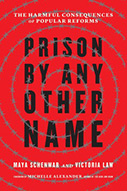Prison By Any Other Name: The Harmful Consequences Of Popular Reforms

Authors: Maya Schenwar and Victoria Law
Publisher: New York: The New Press, 2020. 320p.
Reviewer: Colleen P. Eren | November 2020
Prison By Any Other Name’s authors, Maya Schenwar and Victoria Law, are progressive journalists, prison abolitionists, and people directly impacted by the criminal justice system. Schenwar has spoken openly about her sister’s multiple experiences of incarceration, including while pregnant, in state prison. Victoria Law as a teenager was arrested for armed robbery and given probation. These experiences are invoked in the introduction, and help inform the worldview, evident passion and empathy for the immense suffering generated by the criminal justice system and its ‘sister’ institutions throughout their openly abolitionist book.
Featuring an introduction by Michelle Alexander, Prison by Any Other Name is rooted in in-depth interviews with leaders in the abolitionist movement, including Ruth Wilson Gilmore (author of Golden Gulag), Rachel Herzing (co-founder of the organization Critical Resistance), James Kilgore (former Symbionese Liberation Army member and author of Understanding Mass Incarceration: A People’s Guide to the Key Civil Rights Struggle of Our Time), Alex Vitale (author of The End of Policing) and Mariame Kaba (founder of Project NIA), Prison by Any Other Name. The book’s objectives are several: it provides a sustained critique of the insufficiencies of criminal justice reform initiatives, broadly construed. It aims to provide narratives/stories that illustrate the failures of such reform, and the impact of injustice on individuals’ and communities’ lives. Last, it attempts to stimulate thinking about what an abolitionist future might look like — the forms which it might take.
The book is organized to first present the problem the authors identify with criminal justice reform in the introduction, and then proceed in five subsequent chapters to look at various “fields” in which those problems play out. These six chapters deal with, first, non-custodial, electronic supervision during house arrest or as a ‘substitute’ for jail; second, alternative courts and ‘treatment’ of those with mental illness or substance abuse disorders; third, probation and forced mental health treatment; fourth, child protective services; fifth, community policing; and sixth, policing in schools. The book concludes with examples of what abolition might look like, based on stories of successes in carving room for harm-reduction and community-building as replacements to the criminal justice system. The central argument running through the book, and demonstrated through the chapters, is that there has been an insidious “creep” of the “prison nation” that goes beyond what is traditionally thought of in critical criminological circles as the prison industrial complex. Now, other institutions are becoming annexed to the criminal justice system. Even though on the surface they may seem less harsh, nevertheless they expand the reach of surveillance, punishment, and exclusion from true belonging and the freedom to live one’s life. And, as the authors emphasize, this expanded scope is mostly imposing its inhumanity on Black, Brown, poor, disabled, and gender non-conforming people. It excludes, and seeks to banish these people to institutions and other places that are beyond meaningful social contact and community.
Chapter One, “Your Home is Your Prison,” wades into the very contentious current debate about the role of electronic monitoring as an alternative to custodial sentences, and to monitor people in traditional community supervision like probation, or immigrants who are awaiting proceedings. The chapter provides useful information about the expansion of electronic monitoring over the past five years, and challenges the narratives used in its favor — such as the ability to reduce recidivism or provide for a more humane, higher quality of life. This discussion also illustrates the demands monitoring places on those it ‘polices,’ including the financial costs and impositions on family life.
Although the authors do not actually incorporate his work, Chapter Two, “Locked Down in Treatment,” is evocative of Erving Goffman’s classic sociological text, Asylums, wherein he describes the concept of a total institution, cut off from the rest of society and formally administered, as well as the kinship between prisons and mental hospitals. In this chapter, the authors point out the problems of “alternative” courts such as drug courts, as a way of dealing with the public health problem of substance abuse. Their discussion touches on any kind of mandated drug treatment. For this, they lean heavily on the work of neuroscientist Carl Hart, whose research has challenged the ‘brain disease’ model of addiction. The authors also discuss the widely accepted claim that as asylums were shut down in the U.S., prisons were filled with the same group of people, and thus some argue we should bring back the asylums (or at least mandate treatment) to deal with mental health crises. The authors argue to the contrary that psychiatric labelling and forced “rehabilitation,” and confinement outside of the bounds of society in asylums, only creates more harm.
Chapter Three, “Confined in ‘Community,’” focuses on probation and the myriad ways in which this serves to keep people as second class, “carceral citizens.” It also looks at sex work diversion programs, and mandated outpatient treatment for mental health concerns, making similar arguments as we saw in chapter two about the failures of these ‘alternatives’. The chapter briefly argues against civil commitment and registries for people who have committed sex offenses, presenting the stories of individuals impacted by their being listed on such registries.
Chapters Four and Six describe the expansion of the ‘prison nation,’ illustrating for example how child protective services, while not part of the criminal justice system, overlaps with it in some obvious and not-so-obvious ways. Mandatory reporting laws, ostensibly put in place to protect children, may end up removing them from their families merely because of suspicions of abuse. Such children may then be ‘placed’ with other families who are given state funds not available to the parents themselves to care for the children, and where they may be likely to be tied up in the criminal justice system.
Seemingly well-intended reforms to allow women to care for their children while incarcerated or in the community are critiqued by the authors as constituting yet another form of control over individual autonomy, including in this case, in parenthood. Chapter 6 expands on this, presenting not only well-known information about the school-to-prison pipelines, and the problems of having police in the schools of marginalized students. Keeping with the theme of the book, the authors show how “reforms,” like restorative justice circles, when mandated and involving police in the schools, may ultimately end up reproducing the same old ineffective systems.
Chapter Five, “Communities as Open Air Prisons,” is particularly relevant in the aftermath of the George Floyd murder and subsequent uprisings against police brutality and racism, as community policing has often been offered up as an alternative. Schenwar and Law argue that community policing, while masquerading as more humane and intent on helping and establishing good relationships, is not a viable solution. Instead, they posit that it creates divisions among just who is to be considered a part of the community (a consideration often predicated along racial and class lines). They furthermore contend that it expands networks of surveillance within the community itself that unfairly target those assumed to be engaging in criminal activity (such as what we saw in the George Zimmerman/ Trayvon Martin case). Predictive policing and gang databases, rather than limiting the scope of policing and keeping the neighborhoods most in need safe, may end up as a way to justify profiling, and of ensnaring large groups of (primarily Black men) in databases.
Chapter Six, “Beyond Alternatives,” notes “[a]bolitionists don’t hold one uniform vision. Instead, they champion a range of approaches to work toward a liberated future.” As such, the authors present snapshots of what alternatives to the criminal justice system and its sister institutions might look like. One alternative is to “do nothing,” which essential argues for decriminalization of a range of activities currently labelled as criminal, such as sex work, and not mandating drug abuse or mental health treatment. In terms of drug use and abuse, the authors again bring in the work of Carl Hart and suggest that we should deal with the structural issues of racism, poverty, and lack of fulfillment in work, which may lead people to use substances, and instead provide opportunities for safe use (such as injection sites which have shown to reduce negative public health consequences.) Perhaps most energizing about this chapter is reading about transformative justice, community accountability, and community safety initiatives being forged among communities and organizations, such as the abolitionist Critical Resistance, that attempt to build networks of safety and support outside of the criminal justice system.
If this were not a book by activists intended to encourage abolitionist activism, my critique would be that it sometimes relies too heavily on anecdotes, and too infrequently presents differing views by those directly impacted people who may not share the same political orientation or view of the phenomenon being described. Relatedly, in the sections dealing with addiction, there seems to be an overreliance on the work of a single researcher, without offering any critiques of that research. There is also at times a glossing over of interpersonal harm as a reality in itself, apart from the trauma caused by the criminal justice system.
The authors’ purpose, however, is not to engage in a kind of neutral exposition. They mean to change things. On its own terms, what I would have liked to have seen more of in the book, particularly in the concluding chapter, is an exploration of how explicitly anarchist political sensibilities both currently and historically tie into prison abolitionist work, and potential limitations to this approach. In my reading about Victoria Law, for example, she is described as an anarchist activist; and this lens certainly shapes the arguments in the book and the question of what is to be done. I think it is difficult to imagine the alternatives they are suggesting in the absence of such a political framework—one where the police are removed and community protection is decentralized; where systems of mutual support replace the state; where laws are abolished around most issues related to one’s own consumption of substances, and so forth. This is a fascinating intersection that perhaps can be more fruitfully explored in the future by the authors. Can abolition be achieved without anarchy? What are the limits and perils of such an approach? In the absence of a shift towards anarchy, what are the limits of abolition? Does it meet an impasse given the realities of the government as currently established? In a nation of over 300 million people, how do we resolve issues of harm that arise when committed by someone who is not in our community, or with victim/survivors who do not want to participate in a restorative model? And lastly, there seems to be a paradox, wherein Law and Schenwar argue more financial resources be dedicated by the state to alternatives. This would, however, presumably extend the reach and scope of the governmental apparatus which they have proven operates in a classist and racist manner.
Overall, Schenwar and Law have provided us with an accessible, comprehensive and exciting book about the perils of working towards criminal justice reform, which has become a double-edged sword. It should be required reading and will find a receptive audience among those engaged in activism and the non-profit sector. It should certainly stimulate debate. It should also be useful for undergraduate and graduate classes in sociology and criminology, particularly social movement classes, critical criminology classes, and related classes that examine institutional inequalities. I think it also fills a gap in that it discusses prison abolition using a wider lens — one trained on overlapping institutions that ‘feed’ off of mass incarceration.
Colleen P. Eren, Associate Professor of Sociology and Criminal Justice, William Paterson University


